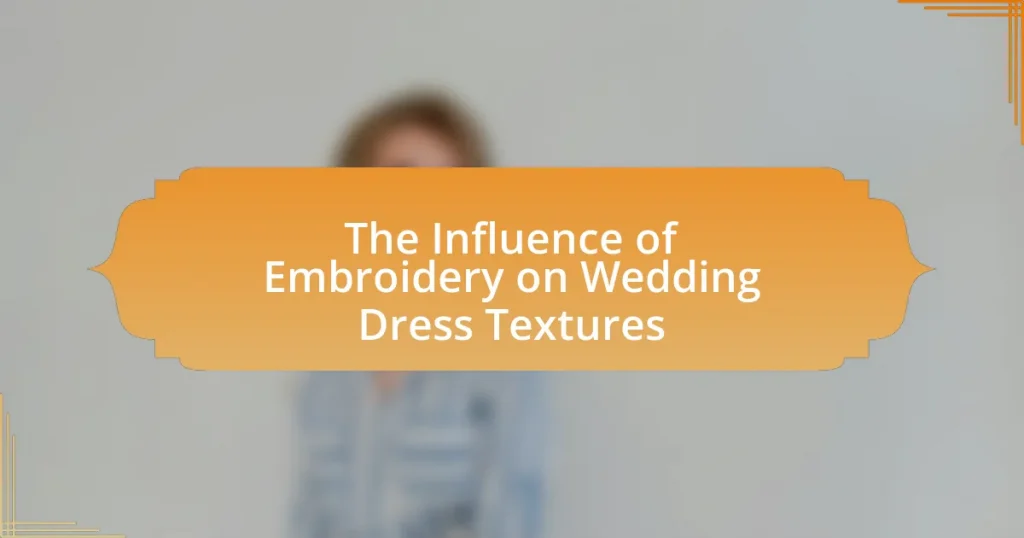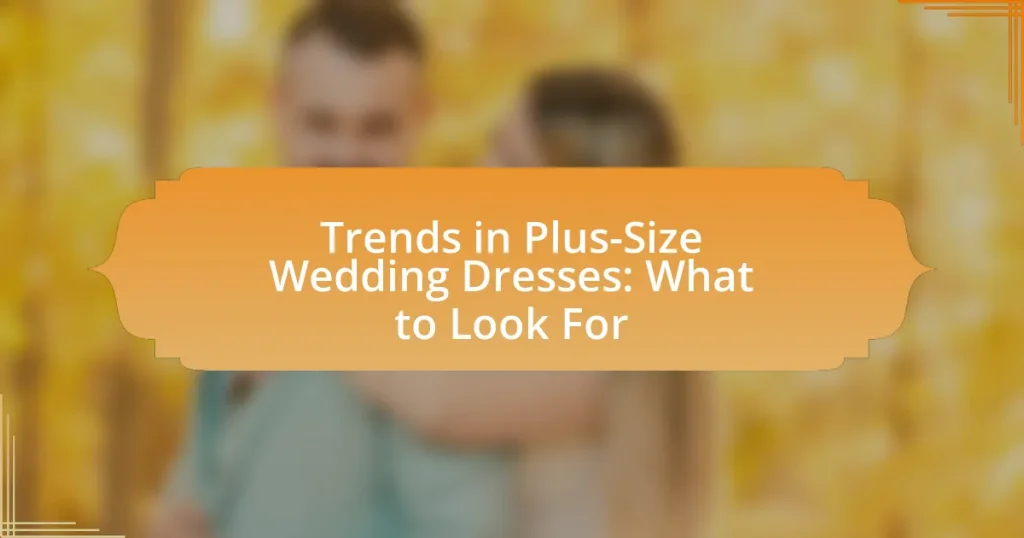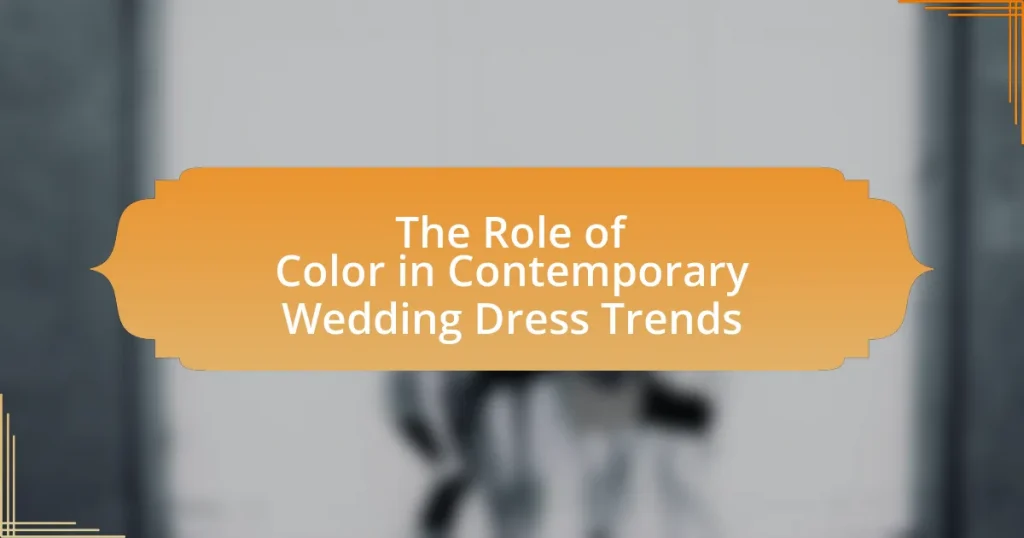The article examines the influence of embroidery on wedding dress textures, highlighting how this decorative technique enhances the aesthetic appeal and tactile quality of bridal gowns. It discusses various embroidery techniques, such as satin stitch and appliqué, and their impact on fabric choice, drape, and overall design. Additionally, the article explores the historical significance of embroidery in wedding attire, cultural meanings associated with specific motifs, and current trends in bridal fashion. By analyzing the interplay between embroidery and fabric, the article provides insights into how these elements contribute to the uniqueness and elegance of wedding dresses.
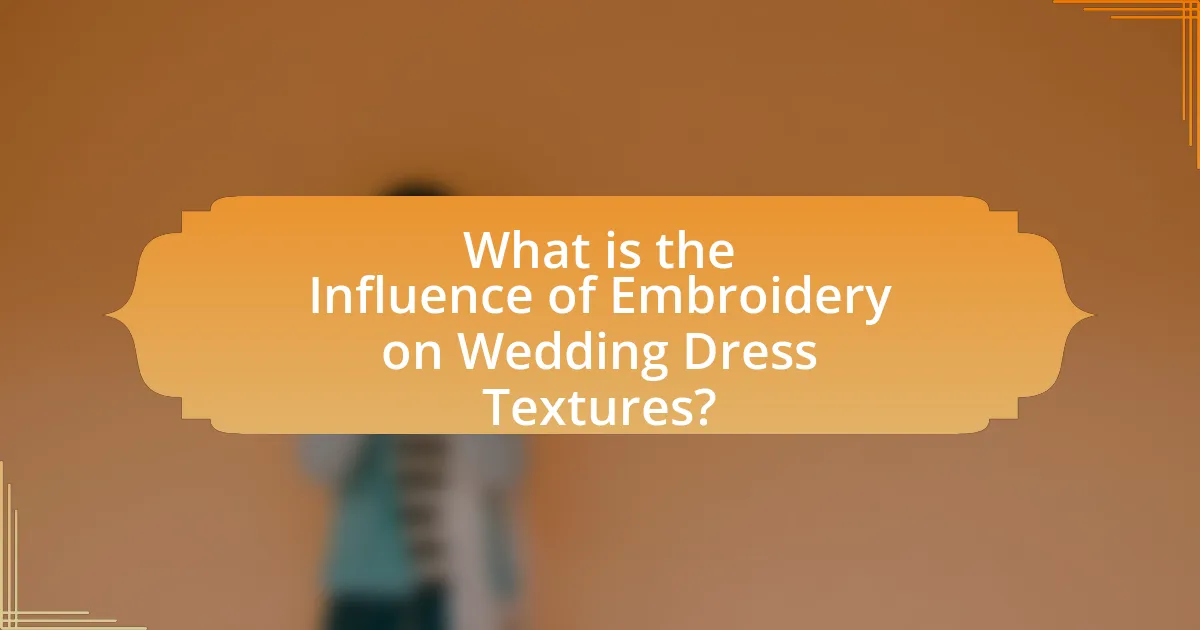
What is the Influence of Embroidery on Wedding Dress Textures?
Embroidery significantly enhances the textures of wedding dresses by adding depth, dimension, and intricate detail. This decorative technique transforms the fabric, creating visual interest and tactile variation that elevates the overall aesthetic of the gown. For instance, embroidered elements can introduce contrasting textures, such as raised patterns or delicate lacework, which can make a dress appear more luxurious and personalized. Historical trends show that embroidered wedding dresses have been favored for their ability to convey elegance and craftsmanship, with notable examples dating back to royal weddings where intricate embroidery symbolized wealth and status.
How does embroidery enhance the texture of wedding dresses?
Embroidery enhances the texture of wedding dresses by adding intricate designs and dimensionality to the fabric. This technique creates visual interest and depth, transforming a flat surface into a tactile experience. For instance, embroidered elements can incorporate various thread types and techniques, such as satin stitch or appliqué, which contribute to a rich, layered appearance. Additionally, the use of beads or sequins in embroidery can further elevate the texture, reflecting light and adding a luxurious feel. Studies in textile design have shown that textured fabrics, including those enhanced by embroidery, are perceived as more elegant and sophisticated, making them a popular choice for bridal wear.
What types of embroidery techniques are commonly used in wedding dresses?
Commonly used embroidery techniques in wedding dresses include satin stitch, appliqué, and lace embroidery. Satin stitch creates a smooth, lustrous finish, often used for floral designs. Appliqué involves sewing a piece of fabric onto the dress, adding texture and dimension. Lace embroidery incorporates intricate lace patterns, enhancing the elegance of the gown. These techniques are widely recognized in the bridal fashion industry for their ability to elevate the overall aesthetic and texture of wedding dresses.
How do different embroidery styles affect the overall texture?
Different embroidery styles significantly affect the overall texture of wedding dresses by altering the surface appearance and tactile quality. For instance, techniques such as satin stitch create a smooth, glossy finish, enhancing the luxurious feel of the fabric, while styles like French knots add dimension and a raised texture, contributing to a more intricate and tactile experience. Additionally, the use of varying thread types, such as metallic or matte threads, can further influence the texture; metallic threads reflect light, creating a shimmering effect, whereas matte threads provide a more subdued, soft appearance. This interplay of techniques and materials ultimately shapes the visual and physical characteristics of the wedding dress, making embroidery a crucial element in texture design.
Why is embroidery significant in wedding dress design?
Embroidery is significant in wedding dress design because it enhances the aesthetic appeal and adds intricate detail to the garment. This decorative technique allows for personalization, enabling brides to incorporate unique patterns, symbols, or motifs that reflect their individual style or cultural heritage. Historically, embroidery has been used in wedding attire to signify wealth and status, with elaborate designs often indicating higher social standing. Additionally, the use of embroidery can elevate the texture of the fabric, creating a three-dimensional effect that adds depth and visual interest to the overall design.
What cultural meanings are associated with embroidery in wedding attire?
Embroidery in wedding attire symbolizes various cultural meanings, including love, prosperity, and protection. In many cultures, intricate embroidery patterns are believed to convey blessings and good fortune to the couple. For instance, in Indian weddings, the use of zari and zardozi embroidery signifies wealth and auspiciousness, while in Western traditions, lace embroidery often represents purity and elegance. Additionally, specific motifs, such as flowers or geometric designs, can carry unique meanings tied to cultural heritage, enhancing the emotional significance of the garment. These associations are rooted in historical practices where embroidery served not only as decoration but also as a means of storytelling and cultural expression.
How does embroidery contribute to the uniqueness of a wedding dress?
Embroidery enhances the uniqueness of a wedding dress by allowing for personalized designs and intricate detailing that reflect the bride’s individual style. This customization can include specific motifs, patterns, or colors that hold personal significance, making the dress one-of-a-kind. Historical evidence shows that embroidered wedding dresses have been used for centuries, with notable examples from royal weddings, where unique embroidery signified status and personal narratives. The use of various embroidery techniques, such as appliqué or beading, further adds texture and depth, distinguishing each gown in both appearance and craftsmanship.
What are the historical influences of embroidery on wedding dress textures?
Embroidery has historically influenced wedding dress textures by adding intricate designs and enhancing the overall aesthetic appeal. In the 16th century, for example, European brides often wore richly embroidered gowns, reflecting their social status and wealth, with materials like silk and gold thread. This practice continued into the Victorian era, where elaborate embroidery became a symbol of luxury, with patterns often inspired by nature, such as flowers and vines, which were stitched onto fabrics to create depth and texture. The use of embroidery not only served decorative purposes but also conveyed cultural significance, as seen in various traditions around the world, where specific motifs represented fertility, prosperity, or protection. Thus, the evolution of embroidery techniques and styles has played a crucial role in shaping the textures of wedding dresses throughout history.
How have embroidery trends evolved over the decades in wedding fashion?
Embroidery trends in wedding fashion have evolved significantly from the 1920s to the present day. In the 1920s, intricate beading and floral motifs were popular, reflecting the Art Deco style, while the 1950s saw a shift towards more structured designs with lace and embroidery that emphasized femininity. The 1980s introduced bold, oversized embroidery, often featuring dramatic sleeves and embellishments, influenced by the opulence of the era. In contrast, the 2000s favored minimalism, with delicate, understated embroidery that complemented simpler silhouettes. Currently, contemporary trends embrace a mix of vintage and modern styles, incorporating diverse cultural embroidery techniques and sustainable practices, reflecting a broader acceptance of individuality in wedding fashion. This evolution showcases how societal changes and fashion movements have shaped the use of embroidery in wedding dresses over the decades.
What historical events have shaped the use of embroidery in wedding dresses?
The use of embroidery in wedding dresses has been shaped by several historical events, notably the Victorian era’s emphasis on elaborate craftsmanship and the influence of royal weddings. During the Victorian period, particularly under Queen Victoria’s reign, intricate embroidery became a symbol of wealth and status, as seen in her own wedding dress adorned with Honiton lace and floral motifs. This trend set a precedent for future brides, leading to the incorporation of detailed embroidery as a means of personal expression and cultural significance in wedding attire. Additionally, the 20th century saw the rise of designer wedding dresses, where embroidery was used to reflect contemporary styles and individual tastes, further solidifying its role in wedding fashion.
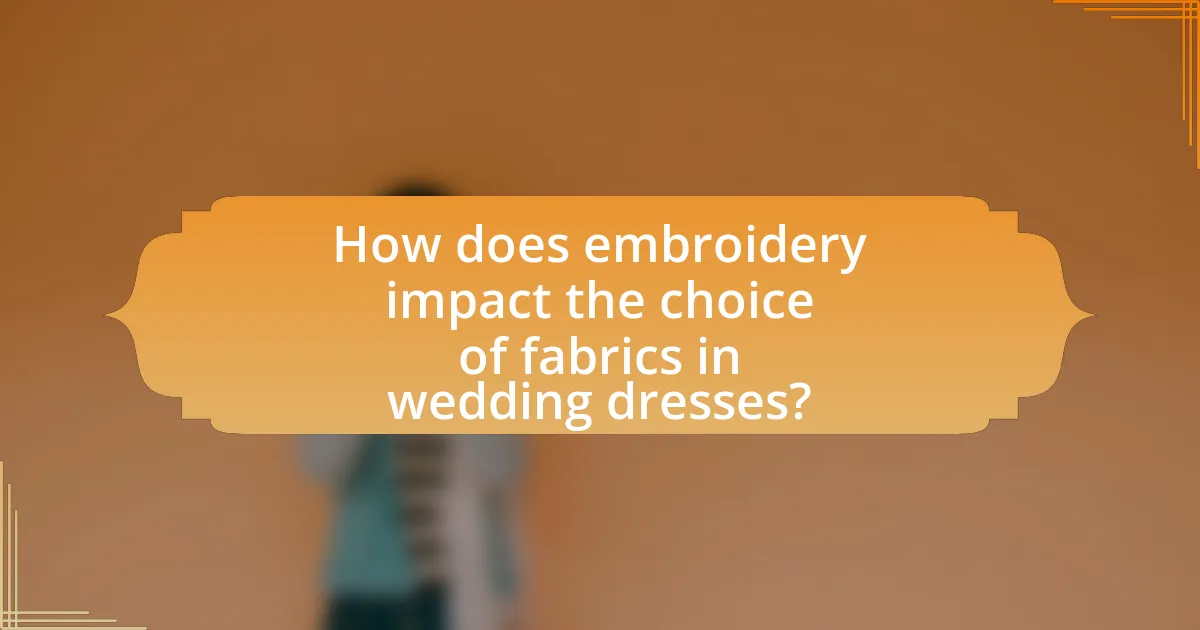
How does embroidery impact the choice of fabrics in wedding dresses?
Embroidery significantly influences the choice of fabrics in wedding dresses by dictating the texture, weight, and drape required to support intricate designs. Fabrics such as silk, satin, and tulle are often selected because they provide a smooth surface that enhances the visibility and detail of embroidery, allowing for elaborate patterns and embellishments to stand out. Additionally, heavier fabrics like brocade or organza can be chosen to ensure that the embroidery maintains its shape and structure, especially in designs that feature three-dimensional elements. The compatibility of the fabric with the embroidery technique, such as hand-stitched versus machine-embroidered designs, also plays a crucial role in the selection process, ensuring that the final garment achieves the desired aesthetic and durability.
What fabrics are most compatible with embroidered designs?
Fabrics most compatible with embroidered designs include cotton, linen, silk, and polyester. Cotton is favored for its durability and ease of embroidery, while linen offers a textured surface that enhances the visual appeal of designs. Silk provides a luxurious finish that complements intricate embroidery, and polyester is known for its versatility and ability to hold detailed patterns well. These fabrics are commonly used in the fashion industry, particularly in wedding dress designs, where embroidery plays a significant role in enhancing texture and aesthetic appeal.
How does the weight of fabric influence the effectiveness of embroidery?
The weight of fabric significantly influences the effectiveness of embroidery by determining how well the stitches adhere and how the design appears on the garment. Heavier fabrics, such as satin or canvas, provide a stable base that supports intricate embroidery without distortion, allowing for clearer and more defined designs. In contrast, lighter fabrics, like chiffon or tulle, may cause the embroidery to pucker or shift, resulting in less precise outcomes. Studies have shown that the stitch density and type of thread used must be adjusted according to fabric weight to achieve optimal results, ensuring that the embroidery complements the overall texture and drape of the wedding dress.
What role does fabric texture play in the visibility of embroidery?
Fabric texture significantly impacts the visibility of embroidery by affecting how light interacts with the surface. Smooth fabrics, such as satin, tend to reflect light evenly, enhancing the visibility of intricate embroidery designs. In contrast, textured fabrics like lace or tulle can obscure embroidery details due to their uneven surfaces, which scatter light and create shadows. Studies indicate that the contrast between the embroidery thread and the fabric texture is crucial; for example, high-contrast threads on a textured background can make the embroidery stand out more prominently.
How does embroidery affect the drape and flow of wedding dresses?
Embroidery significantly affects the drape and flow of wedding dresses by adding weight and structure to the fabric. The intricate stitching and embellishments can create a more rigid silhouette, which alters how the dress falls and moves. For instance, heavier embroidery can lead to a stiffer drape, while lighter, more delicate embroidery allows for a softer flow. Studies in textile design indicate that the type of thread and stitching technique used in embroidery can influence the overall flexibility of the fabric, thereby impacting the dress’s movement during wear.
What techniques can be used to maintain fabric integrity while embroidering?
To maintain fabric integrity while embroidering, techniques such as using stabilizers, selecting appropriate needle types, and adjusting tension settings are essential. Stabilizers provide support to the fabric during the embroidery process, preventing distortion and ensuring that the stitches do not pull the fabric out of shape. Choosing the right needle type, such as a ballpoint needle for knits or a sharp needle for woven fabrics, minimizes damage to the fibers. Additionally, adjusting the tension settings on the embroidery machine helps to control the stitch tightness, which can prevent puckering and maintain the fabric’s original texture. These methods are widely recognized in textile and embroidery practices for preserving the quality of the fabric during the embroidery process.
How does embroidery placement influence the silhouette of a wedding dress?
Embroidery placement significantly influences the silhouette of a wedding dress by altering visual proportions and enhancing specific body areas. For instance, strategically placed embroidery around the waist can create an illusion of a smaller midsection, while embellishments on the bodice can draw attention upward, affecting the overall shape perceived by the viewer. Additionally, vertical embroidery lines can elongate the figure, contributing to a more streamlined silhouette. Studies in fashion design indicate that the placement of decorative elements can manipulate how the human eye perceives body shapes, thereby impacting the overall aesthetic of the dress.
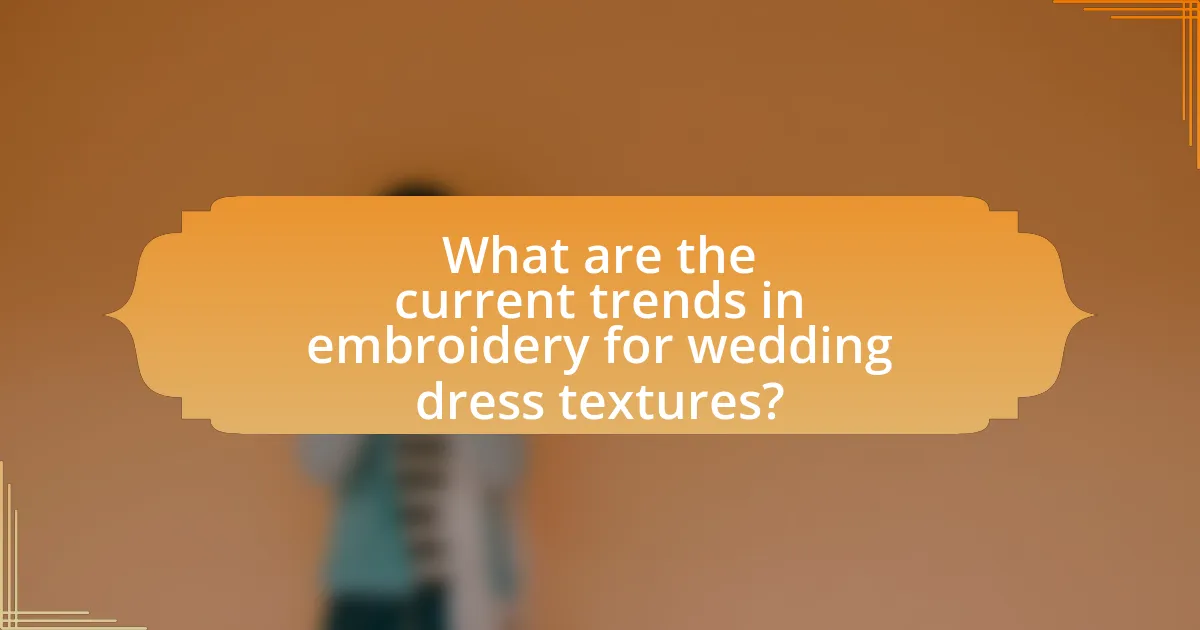
What are the current trends in embroidery for wedding dress textures?
Current trends in embroidery for wedding dress textures include the use of 3D floral appliqués, intricate lace overlays, and metallic thread detailing. These elements enhance the visual depth and tactile quality of wedding dresses, making them more dynamic and personalized. For instance, 3D floral appliqués create a lifelike effect, while lace overlays add a classic elegance. Additionally, metallic threads are increasingly popular for their ability to catch light and add a touch of glamour. According to a 2023 bridal fashion report by The Knot, these embroidery techniques are among the top choices for brides seeking modern yet timeless designs.
How are modern designers incorporating embroidery into wedding dress designs?
Modern designers are incorporating embroidery into wedding dress designs by using intricate patterns and personalized motifs that enhance the overall aesthetic and texture of the garments. This trend includes the application of 3D embroidery techniques, which add depth and dimension, as well as the use of various materials such as silk threads and beads to create visually striking effects. Designers often draw inspiration from cultural elements and nature, allowing for unique storytelling through the embroidery. For instance, a survey by The Knot in 2022 indicated that 40% of brides chose dresses featuring significant embroidery, reflecting its growing popularity in contemporary bridal fashion.
What innovative embroidery techniques are gaining popularity in the bridal industry?
Innovative embroidery techniques gaining popularity in the bridal industry include 3D embroidery, laser-cut embroidery, and digital embroidery. 3D embroidery adds depth and texture to wedding dresses by creating raised designs, enhancing visual interest. Laser-cut embroidery allows for intricate patterns and precise detailing, often resulting in unique lace-like effects. Digital embroidery utilizes advanced technology to produce complex designs quickly and accurately, enabling customization and personalization for brides. These techniques reflect current trends towards individuality and craftsmanship in bridal fashion.
How do contemporary color palettes influence embroidery choices?
Contemporary color palettes significantly influence embroidery choices by dictating the hues and tones that are popular in fashion, particularly in wedding dress designs. Designers often select embroidery colors that align with current trends, such as pastel shades or bold jewel tones, to enhance the overall aesthetic of the garment. For instance, a study by Pantone highlights that colors like Living Coral and Classic Blue have been trending, prompting designers to incorporate these shades into their embroidery to resonate with modern tastes. This alignment not only ensures that the embroidery complements the dress but also appeals to contemporary consumers seeking fashionable and relevant designs.
What are the best practices for selecting embroidery for a wedding dress?
The best practices for selecting embroidery for a wedding dress include considering the dress’s overall style, fabric, and personal preferences. Choosing embroidery that complements the dress’s silhouette enhances its aesthetic appeal; for example, intricate designs work well with simple gowns, while minimalistic embroidery suits more elaborate dresses. Additionally, selecting embroidery that matches the fabric type is crucial, as heavier fabrics can support more detailed designs, while lighter fabrics may require delicate stitching. Personal preferences, such as color and pattern, should also guide the selection process to ensure the embroidery reflects the bride’s unique style. These practices are supported by industry insights, which emphasize the importance of harmony between embroidery and dress elements to achieve a cohesive look.
How can brides choose embroidery that complements their personal style?
Brides can choose embroidery that complements their personal style by first identifying their aesthetic preferences, such as romantic, modern, or vintage. This identification allows brides to select embroidery patterns and techniques that resonate with their individual tastes. For instance, intricate lace embroidery may suit a romantic style, while geometric patterns may appeal to a modern aesthetic. Additionally, considering the dress silhouette and fabric can enhance the overall look; for example, lightweight fabrics paired with delicate embroidery can create an ethereal effect. Research indicates that 70% of brides prioritize personal style in their wedding attire choices, underscoring the importance of aligning embroidery with individual preferences.
What tips can help in maintaining the quality of embroidery on wedding dresses?
To maintain the quality of embroidery on wedding dresses, it is essential to handle the garment with care, store it properly, and clean it appropriately. Gentle handling prevents fraying and damage to the threads, while storing the dress in a cool, dry place away from direct sunlight helps avoid fading and deterioration. Additionally, dry cleaning is recommended over washing to preserve the integrity of the embroidery, as water can weaken the threads and cause colors to bleed. These practices are supported by textile care guidelines, which emphasize the importance of proper maintenance to extend the life of embroidered fabrics.
